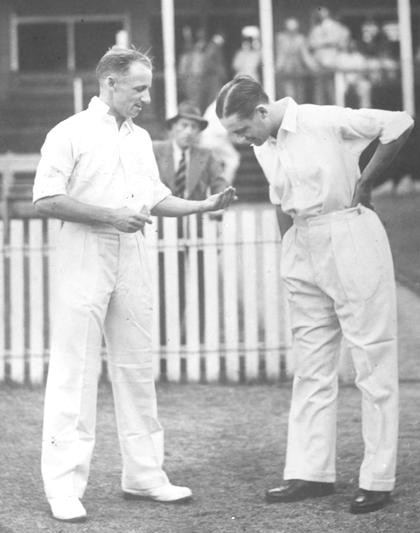 | ||
In the sport of cricket, a coin is tossed to determine which team bats first. This is known as the toss.
Contents
Before play begins, the captain of each side will inspect the pitch. Based on the pitch and weather conditions, the captains select their final eleven players. If the pitch is soft or dusty, the captain will tend to select more spin bowlers; if the pitch is hard, the choice tends to favour fast bowlers at the expense of spinners.
Half an hour before the start of play, the two captains convene and exchange team selection sheets. These list the composition of each side, which cannot be changed for the duration of the match. Then, with the supervision of the umpires, a coin is tossed to determine who bats first. The umpire's call of play marks the official beginning of the match. If the match is abandoned at any time after the toss, it stands as a match played and enters official statistical records. If a match is abandoned before the toss, it is not considered to have been played at all, and does not count for records.
The captain who wins the toss must choose whether to bat or field. The decision is of great tactical importance, and the captain will have considered many variables before arriving at his decision. Because of the different natures of the games, it is considerably more common to choose to bat second in one-day cricket than it is in Test cricket.
From 2016 in the England County Championship there will be no mandatory toss, with the away side having the choice if they wish to field first. If the away side declines to field first, the toss will still take place.
Batting first
If the team is uncertain about the nature of the pitch or simply wants to play safe, they often bat first. If the opposition bowling is strong batting first is often considered a good option. Sometimes the nature of the pitch deteriorates while the game progresses, making batting more difficult especially if facing spin bowling. Another advantage of batting first is that the batting team sets a target for the team batting second to chase. This can create pressure on the teams batsmen and cause problems for the team batting second.
Batting second
The captain opts to bat second if he is confident that his team can successfully chase any total. Once the target is known, the team does not have to worry about setting a winnable score. The team just has to limit the opposition to a low score, and bat well to successfully chase the target. If the pitch does not deteriorate, batting second is usually a better option. Another advantage of batting second is during day-night One Day International games, played under lights. In some venues, the cricket ball collects a lot of dew in the outfield. This results in a poor grip on the ball by the bowlers. With a moist ball it is difficult to spin and swing the ball. The difficulty in holding the ball also means that the bowler is more likely to be inaccurate, giving the batsmen more ill-directed deliveries to hit.
Influence of toss on outcome
Winning the toss provides a small, but significant improvement to a team's chances of winning.
Based on the 2,106 Test matches played up to 13 December 2013:
Based on all One Day International matches played up to 27 December 2006:
History
In the first known code of laws published in 1744, the side winning the toss had the choice of the pitch that was to be used as well as whether to bat first. In the 1774 code this was changed, the visiting team to have the choice of both the pitch and whether to bat first. By about 1809, the modern practice had been adopted, with the choice of pitch left to the umpires and the toss determining which side had the choice of whether to bat first.
